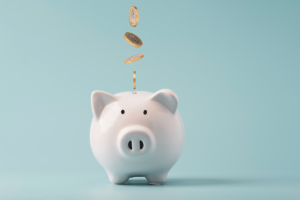How to Grow Your Savings Rate

This Is How a Rapid Rescore Can Boost Your Credit Score Fast
11/19/2023
Do Tradelines Still Work in 2024?
12/06/2023 Saving more money is solid financial advice. In theory, we all know that saving money is important. But when it comes to managing our funds, it can be difficult to track how much of our income we actually save. Luckily, it’s easy to calculate your savings rate, which can serve as a measure of your savings strategy over time.
Saving more money is solid financial advice. In theory, we all know that saving money is important. But when it comes to managing our funds, it can be difficult to track how much of our income we actually save. Luckily, it’s easy to calculate your savings rate, which can serve as a measure of your savings strategy over time.
Let’s explore what your savings rate is, how to calculate it, and how to grow this important number.
What Is a Savings Rate?
A savings rate is the percentage of income that you save. The simple number has a big impact on your financial situation. After all, a higher savings rate means you have the ability to invest in a bright financial future. Ideally, you’ll have a positive savings rate. But if you are spending more than you make, you will have a negative savings rate.
According to the Bureau of Economic Analysis, the average personal savings rate was 5.1% in March 2023. But as an individual, you can choose what is an ideal savings rate for your situation.
Why Does Your Savings Rate Matter?
Saving money is a key part of building a stable financial foundation. Unfortunately, saving money isn’t always fun. Choosing to save money for the future can mean giving up fun splurges now.
It can be tempting to give in to overspending in a consumerist society. But choosing to focus on growing your savings rate instead can set you up for a bright financial future.
Below is a closer look at some of the most important reasons to focus on your savings rate.
Measures Your Ability to Grow Your Savings
“What gets measured gets improved,” as the saying goes. In terms of your savings rate, keep this idiom in mind. As you manage your household finances, keeping tabs on your savings rate can help you determine what direction your finances are moving in.
Since a higher savings rate leads to a solid financial foundation, you might find more motivation to improve your savings rate over time by measuring this number. If you don’t measure your savings rate, you might assume that you are saving more than you actually are.
Confirms You Are on Track Toward Your Financial Goals
The reality is that life can get expensive, which means that saving money isn’t always easy. While saving money isn’t always the comfortable choice, you can use the metric to confirm you are on track toward big financial goals.
For example, if you have a goal to buy a home in a few years, you can use your savings rate to confirm you are saving enough for a down payment. If you notice that your savings rate is dropping, you can make adjustments to get back on track.
Helps Ensure You Are Saving Something
A positive savings rate indicates you are setting aside something for the future. Whether your savings rate is 1%, 75%, or somewhere in between, saving any amount of money is better than not saving anything at all.
If you determine that you have a negative savings rate, you are spending more than you make. A negative savings rate often means you are taking on debt to support your lifestyle. At this point, you’ll likely need to make some changes to turn the tables.
Gives You a Cushion for Unexpected Expenses
Life has a habit of throwing unexpected expenses your way. When you encounter an unexpected expense, a higher savings rate will give you room to absorb those costs.
For example, if your car’s engine light comes on, you are in a better position to cover those costs if you have savings to fall back on.
Helps You Protect Your Credit Score
A healthy savings rate allows you to tuck funds away for the future. For many savers, the first priority is to build an emergency fund. While experts often recommend storing between three to six months of expenses in an emergency fund, any amount of savings is better than nothing.
If you get hit with an unexpected bill, you can lean on your savings instead of reaching for your credit card or another form of financing. The ability to avoid taking on new debts can help you protect your credit score from the pressure of added monthly bills.
Since a good credit score can help you unlock better financing opportunities, the benefit of a higher savings rate cannot be overlooked.
How to Calculate Your Savings Rate
The math behind your savings rate is simple. You can find your savings rate by dividing the amount you save by your income.
For example, if you save $1,000 per month with a net income of $4,000, then your savings rate is 25%. A bigger gap between your income and expenses leads to a higher savings rate.
How to Grow Your Savings Rate
If you want to grow your savings rate, the answer is simple, you’ll either need to decrease your expenses or increase your income. Below you’ll find some strategies to help you improve your savings rate.
Track Your Expenses
Tracking your expenses is the first step to increasing your savings rate. Without a clear understanding of how much money you spend each month, you cannot get an accurate estimate of your savings rate.
You can automate this chore or manually tally up your expenses each month. Manually tracking your expenses might include writing down your transactions in a notebook or recording your monthly spending in a spreadsheet.
If you don’t want to add any friction to this task, you can choose an automated option. For example, you can use an app like Mint, which links to your bank accounts and categorizes your expenses for you.
Be Honest About Your Spending
It’s easy to get emotions wrapped up in your spending. But if you want to make saving money a priority, it’s essential to be honest about your spending. Unless you can be honest about your spending, it’s almost impossible to stick to a budget or improve your savings rate.
Typically, being honest about your spending is easier when you build a budget that prioritizes your goals. For example, choosing to set aside a substantial amount of savings each month might lead to the dream home or luxurious vacation you’ve been saving for. When you can tie saving money to your dreams, it’s often easier to stick with your budget. And if you stick with your budget, you won’t need to hide your spending habits from yourself.
Cut Out Unnecessary Spending
When you want to improve your savings rate, cutting out unnecessary spending is an obvious place to get started. After tracking your expenses for at least a few weeks, you might spot areas that you want to cut back on.
A few places to cut back might include:
- Restaurant food: While picking up takeout or heading out for a night on the town can lead to great food, it often comes with a big price tag. Take a look at your spending on restaurant food. Cutting back on eating out can have a positive impact on your savings rate.
- Subscriptions: Most of us sign up for subscriptions and then forget to cancel them. If you are paying for subscription services that you don’t use, cancel them ASAP.
When you take a look at your own spending, hopefully, you’ll see at least one or two spending categories that you can cut back on.

Pay Down Debt
Monthly debt payments can take a big bite out of your paycheck and have a big impact on your savings rate. If you feel the pinch of debt on your monthly budget, paying off those loans early could help you boost your savings rate. After all, you can push the funds formerly consumed by debt payments into your savings.
Not sure where to start paying off your debts? Consider the snowball or avalanche methods.
The snowball method focuses on paying off your loans with the smallest balance first. You can funnel any extra funds you have available for debt repayment into your smallest debt. When you eliminate one debt, you can roll the minimum payment into your debt snowball, which can be used to tackle your next largest debt. You’ll repeat the process until you’ve paid off all of your debts.
In contrast, the avalanche method focuses on paying off the debt with the highest interest rate first. As you pay off debts, you’ll move on to the debt with the next highest interest rate.
When you eliminate debt from your budget, you’ll have more breathing room to save each month.
Lower Your Biggest Expenses
Cutting out smaller expenses can help you boost your savings rate. But focusing on your largest expenses can help you make the biggest impact on your savings. Some of the biggest expenses facing American budgets include housing, transportation, and food. With each of these categories, you can make big changes for a lasting impact on your savings rate.
For example, downsizing your living space could help you lock in lower housing costs. Other savers choose unconventional living situations, like house hacking or geographic arbitrage to lock in more affordable housing. With house hacking, you’ll essentially buy a place and rent out the extra space. The rental income you produce can help you lower your housing costs. With geo-arbitrage, you move to another location with the express purpose of finding lower housing costs.
In terms of your transportation, driving an older vehicle or giving up your vehicle altogether can help you save in a big way.
Evaluate Your Income
While most of us start by lowering our expenses, increasing your income is another way to improve your savings rate. In fact, increasing your income could be a more sustainable way to maintain a relatively high savings rate over the long term.
Before you jump into increasing your income, start by evaluating your income. Take a look at all of your income streams. Be realistic about whether or not the income you bring in is enough to build the lifestyle you desire. If you have a strong income, you might not need to push for more if you stay on top of your spending. If you have a lower income than you desire, working to boost your income can lead to a higher savings rate.
Ask for a Raise
The first place to look for a better income is by asking your current employer for a raise. While the prospect of approaching your employer with this request might seem daunting, it could pay off in a big way. After all, you’ll never know unless you ask.
Get a New Job
If you aren’t able to get a raise from your current employer, consider looking for a higher-paying job in your field. In some cases, you might find a higher paycheck and better work environment by switching up your employment situation.

Pick up a Side Hustle
A side hustle offers a way to build your income without giving up your day job. Side hustles come in all shapes and sizes. The best part is that you can choose a side hustle that gets you excited to put in the work.
A few examples of side hustles include walking dogs, babysitting, freelance writing, building a blog, selling your artwork on Etsy, and more. Do some research about turning an interest of yours into an extra source of income.
Build Multiple Streams of Income
When you have multiple streams of income, you have more flexibility. If a single income stream dries up, you can fall back on your others. Making the effort to build multiple streams of income can pay off in the form of a higher income and a higher savings rate.
Get creative when building your income streams. Consider adding passive streams of income, like investing and savings products, with more active income streams, like starting a small business or walking dogs in your neighborhood.
FAQs
Is a 20% Savings Rate Good?
Many experts recommend saving at least 20% of your income. However, the reality is that most people save much less. According to the BEA, the average personal savings rate was 5.1% in March 2023. Even if you can’t save 20% of your income now, aim to save as much as you can and increase that amount over time.
Is Saving $1,500 a Month Good?
Saving any amount of money each month is a worthwhile goal. With that, saving $1,500 per month is definitely good. But your income and savings goals will indicate whether or not saving $1,500 is the right fit for your situation. For example, if you are trying to save $24,000 for a down payment within a year, you’ll need to set aside more money each month.
Is $20,000 a Lot in Savings?
Having $20,000 in the bank is a good thing. But whether or not it is a healthy amount of savings varies based on your situation. For example, if you are planning to retire within a year, having just $20,000 in savings might not be enough. In contrast, if you are just starting your career, $20,000 in savings might serve as a solid financial foundation.
The Bottom Line
Saving money is undeniably important. If you want to build your savings, try focusing on your savings rate. The right savings rate can make all the difference to your finances.




